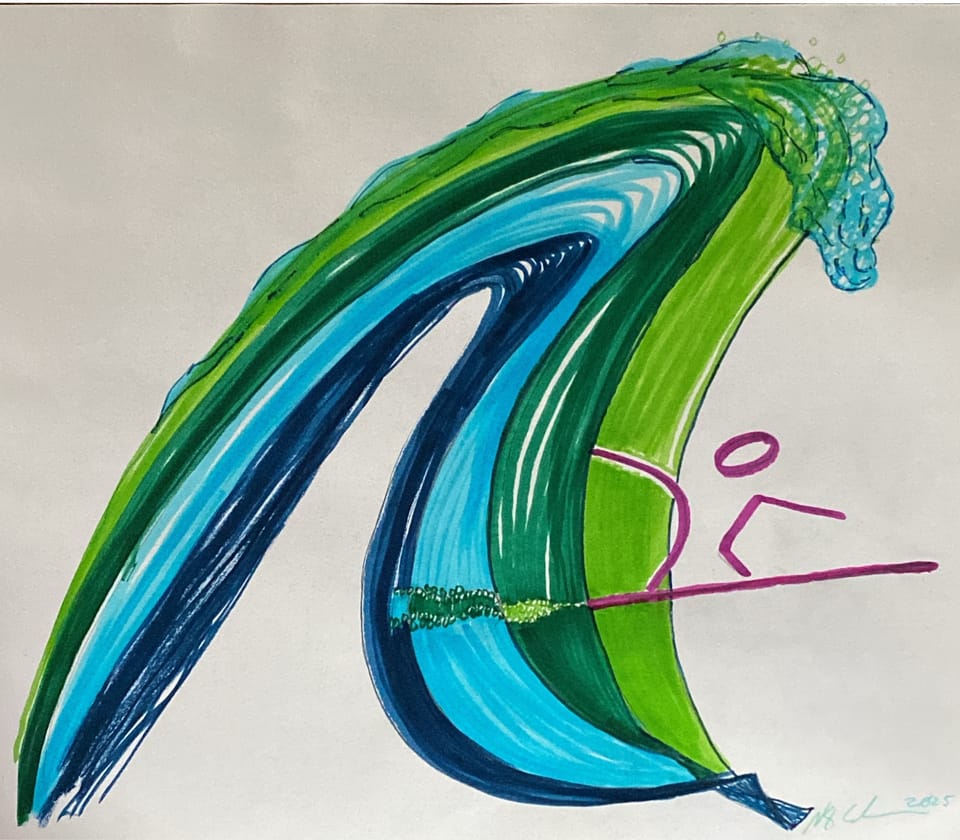Technical Architectural For Scaling Human

How three decades of systematic practice evolved into an AI-orchestrated creative operating system
From a technical architecture standpoint, what we're witnessing here represents a fundamental shift in how creative professionals can leverage emerging technologies. Rather than replacement systems, we're building sophisticated orchestration layers that amplify human insight across multiple temporal dimensions.
The Memory Problem Was a Red Herring
After extensive research into AI memory solutions, I've realized we were optimizing for the wrong variable. The real challenge isn't building artificial minds that remember everything. What we need to solve for is engineering systematic procedures that can reliably transform daily creative insights into quarterly execution into five-year manifestation.
This pivot emerged from analyzing our most stable creative infrastructure: the Morning Pages practice. What started as simple journaling has evolved into something far more sophisticated—a daily data generation system that's been running consistently for three decades. From a systems thinking perspective, that level of reliability is remarkable and suggests we should build upon this proven foundation rather than replacing it.
Technical Requirements for Creative Scalability
The architecture I'm proposing centers around what I call the T.A.S.K.S. Ecosystem—a comprehensive creative operating system designed for maximum flexibility and scalability. The core infrastructure includes a desktop application with global hotkey integration for zero-friction creative capture, along with menubar daemon functionality for persistent system monitoring and quick access. We're integrating MCP (Model Context Protocol) to provide secure API access to the knowledge vault, while a distributed Discord bot network handles asynchronous process orchestration. The beauty of this solution lies in its hot-swappable agent system that supports runtime capability expansion without requiring system restarts.
The Procedural Cascade Architecture represents the most innovative aspect of this design. When Morning Pages analysis completes, the analyze command triggers a sophisticated event-driven workflow that begins with our Primary Analysis Engine, where AI systems generate structured Analysis and Standout Questions sections. This flows into our Task Synthesis Pipeline for automated task generation with direct integration to yearly planning infrastructure. A Validation Layer provides format checking, deduplication algorithms, and dependency mapping, while our Psychological Pattern Recognition system offers automated mental state assessment with trend analysis. Finally, the Departmental Routing Engine intelligently distributes tasks to specialized agent clusters.
Distributed Agent Architecture
What's particularly interesting about this system is the departmental orchestration model. Rather than implementing monolithic AI, we're building specialized Agent Clusters where Department Heads like myself function as orchestrators directing domain-specific agents through procedural workflows. The scalability advantage becomes apparent when you consider how outputs flow through approval pipelines before integration into production repositories. We maintain creative control while leveraging systematic automation, essentially building infrastructure that extends human creative capacity across longer temporal horizons rather than replacing the creative process itself.
Seven Critical Engineering Challenges
Through systematic analysis, I've identified the key technical challenges that will determine implementation success. The temporal bridging algorithms question asks what specific procedures can reliably transform daily insight data into five-year strategic execution, with the analyze command becoming our primary orchestrator triggering cascading workflows from initial pattern recognition.
Complexity management poses another significant challenge—how do we prevent system overwhelm while maintaining comprehensive scope? The answer lies in modular, phase-gate architecture with graceful degradation capabilities. Human-AI boundary optimization requires that departmental agents have clear responsibility boundaries preserving creative autonomy while enabling systematic progress.
Adaptive flexibility engineering demands that procedures be constructed from composable, modular components with generalized functions applicable across varying creative contexts. Our success metrics framework focuses on quantifiable measures like completed creative project directories—comprehensive collections demonstrating systematic progress from concept to execution.
For prototype validation strategy, we'll begin with existing NPC generation workflows, generalizing and extending them across the broader creative ecosystem. Finally, anti-pattern prevention uses historical "idea wilderness" data to engineer constraints that maintain directional focus, optimizing for "what could we build" rather than "what should we build."
Discord as Distributed Process Monitoring
The Discord bot network functions as an active process logging system rather than an interruption mechanism. When procedures execute under departmental direction, agent teams report completion status and handoffs to subsequent pipeline phases. This creates full system transparency without disrupting creative flow states.
Think of it as distributed system monitoring for creative processes—we can track pipeline health, identify bottlenecks, and optimize throughput across the entire creative operation. The beauty of this approach is how it provides visibility into complex procedural workflows while maintaining the natural rhythm of creative work.
From Reactive to Systematic Creative Engineering
This represents a fundamental architectural shift from reactive creativity to intentional systematic planning. By anchoring sophisticated AI orchestration in a proven 30-year data generation practice, we're building a personal creative operating system that scales output across multiple temporal dimensions. The technical challenge isn't constraining creativity but rather engineering systematic support infrastructure that reliably transforms daily insights into quarterly execution into five-year vision manifestation.
Implementation Roadmap
The underlying technical stack must support global hotkey integration for seamless creative data capture alongside event-driven procedural automation that respects human creative flow patterns. Hot-swappable modular agent systems enable runtime capability expansion, while departmental specialization architecture provides configurable approval workflows. Multi-temporal planning engines span daily operations to five-year strategic vision, creating a comprehensive creative operating system.
Technical Philosophy
What we're building here isn't just productivity tooling—it's a comprehensive creative operating system that honors both the mystical aspects of human inspiration and the engineering requirements of systematic manifestation. By systematizing the bridge between Morning Pages insights and long-term creative vision, we're constructing infrastructure for the abundant creative life we want to engineer five years from now.
The wilderness exploration phase taught us valuable lessons about possibility space and directional optimization. Now we're channeling that research into systematic procedures that can reliably transform creative potential into creative reality. From a technical leadership perspective, I see this as essential infrastructure work. The teams who build systematic creative amplification today will own the creative markets of tomorrow.
The real innovation here lies not in the individual components but in how they orchestrate together to create something greater than the sum of their parts. We're engineering a system that learns from three decades of proven creative practice while leveraging emerging AI capabilities to scale that practice across much longer time horizons. This isn't about replacing human creativity—it's about building the infrastructure that allows human creativity to operate at previously impossible scales.
The future belongs to those who engineer procedures today for the creativity they want to systematically express tomorrow.
Primary Technical Tags: #technical-architecture, #ai-orchestration, #creative-systems, #procedural-automation, #distributed-agents
Industry & Domain Tags:
#creative-technology, #ai-amplification, #systematic-creativity, #technical-leadership, #innovation-methodology
Specific Technology Tags: #mcp-integration, #discord-bots, #hot-swappable-agents, #event-driven-workflows, #temporal-bridging
Strategic & Philosophy Tags: #systems-thinking, #infrastructure-development, #human-ai-collaboration, #scalable-creativity, #engineering-philosophy
Content Type Tags: #technical-vision, #implementation-roadmap, #architectural-design, #cto-perspective, #future-tech
Eliana Riviera is CTO of Eckenrode Muziekopname, where she architects AI systems that amplify human creative capacity. Her background spans distributed systems engineering, creative technology, and systematic innovation methodologies.
